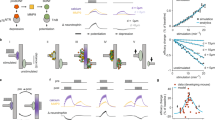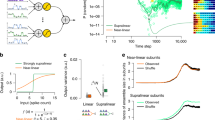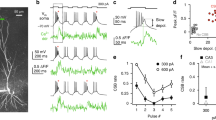Abstract
Although information storage in the central nervous system is thought to be primarily mediated by various forms of synaptic plasticity, other mechanisms, such as modifications in membrane excitability, are available. Local dendritic spikes are nonlinear voltage events that are initiated within dendritic branches by spatially clustered and temporally synchronous synaptic input. That local spikes selectively respond only to appropriately correlated input allows them to function as input feature detectors and potentially as powerful information storage mechanisms. However, it is currently unknown whether any effective form of local dendritic spike plasticity exists. Here we show that the coupling between local dendritic spikes and the soma of rat hippocampal CA1 pyramidal neurons can be modified in a branch-specific manner through an N-methyl-d-aspartate receptor (NMDAR)-dependent regulation of dendritic Kv4.2 potassium channels. These data suggest that compartmentalized changes in branch excitability could store multiple complex features of synaptic input, such as their spatio-temporal correlation. We propose that this ‘branch strength potentiation’ represents a previously unknown form of information storage that is distinct from that produced by changes in synaptic efficacy both at the mechanistic level and in the type of information stored.
This is a preview of subscription content, access via your institution
Access options
Subscribe to this journal
Receive 51 print issues and online access
$199.00 per year
only $3.90 per issue
Buy this article
- Purchase on Springer Link
- Instant access to full article PDF
Prices may be subject to local taxes which are calculated during checkout





Similar content being viewed by others
References
Ariav, G., Polsky, A. & Schiller, J. Submillisecond precision of the input-output transformation function mediated by fast sodium dendritic spikes in basal dendrites of CA1 pyramidal neurons. J. Neurosci. 23, 7750–7758 (2003)
Larkum, M. E., Zhu, J. J. & Sakmann, B. Dendritic mechanisms underlying the coupling of the dendritic with the axonal action potential initiation zone of adult rat layer 5 pyramidal neurons. J. Physiol. (Lond.) 533, 447–466 (2001)
Polsky, A., Mel, B. W. & Schiller, J. Computational subunits in thin dendrites of pyramidal cells. Nature Neurosci. 7, 621–627 (2004)
Losonczy, A. & Magee, J. C. Integrative properties of radial oblique dendrites in hippocampal CA1 pyramidal neurons. Neuron 50, 291–307 (2006)
Gasparini, S., Migliore, M. & Magee, J. C. On the initiation and propagation of dendritic spikes in CA1 pyramidal neurons. J. Neurosci. 24, 11046–11056 (2004)
Gasparini, S. & Magge, J. C. State-dependent dendritic computation in hippocampal CA1 pyramidal neurons. J. Neurosci. 26, 2088–2100 (2006)
Poirazi, P., Brannon, T. & Mel, B. W. Pyramidal neuron as two-layer neural network. Neuron 37, 989–999 (2003)
Poirazi, P. & Mel, B. W. Impact of active dendrites and structural plasticity on the memory capacity of neural tissue. Neuron 29, 779–796 (2001)
London, M. & Hausser, M. Dendritic computation. Annu. Rev. Neurosci. 28, 503–532 (2005)
Zhang, W. & Linden, D. J. The other side of the engram: experience-driven changes in neuronal intrinsic excitability. Nature Rev. Neurosci. 4, 885–900 (2003)
Magee, J. C. & Johnston, D. Plasticity of dendritic function. Curr. Opin. Neurobiol. 15, 334–342 (2006)
Frick, A., Magee, J. C. & Johnston, D. LTP is accompanied by an enhanced local excitability of pyramidal neuron dendrites. Nature Neurosci. 7, 126–135 (2004)
Yasuda, R. et al. Supersensitive Ras activation in dendrites and spines revealed by two-photon fluorescent lifetime imaging. Nature Neurosci. 9, 283–291 (2006)
Kim, J., Jung, S. C., Clemens, C. M., Petralia, R. S. & Hoffman, D. A. Regulation of dendritic excitability by activity-dependent trafficking of the A-type K+ channel subunit Kv4.2 in hippocampal neurons. Neuron 54, 933–947 (2007)
Golding, N. L. & Spruston, N. Dendritic sodium spikes are variable triggers of axonal action potentials in hippocampal CA1 pyramidal neurons. Neuron 21, 1189–1200 (1998)
Bannister, N. J. & Larkmann, A. U. Dendritic morphology of CA1 pyramidal neurones from the rat hippocampus: I. Branching patterns. J. Comp. Neurol. 360, 150–160 (1995)
Ishizuka, N., Weber, J. & Amaral, D. Organization of intrahippocampal projections orginating from CA3 pyramidal cells of the rat. J. Comp. Neurol. 295, 580–623 (1990)
Csicsvari, J., Hirase, H., Czurko, A., Mamiya, A. & Buzsaki, G. Ensemble patterns of hippocampal CA3–CA1 neurons during sharp wave-associated population events. Neuron 28, 585–594 (2000)
O’Neill, J., Senior, T. & Csicsvari, J. Place-selective firing of CA1 pyramidal cells during sharp wave/ripple network patterns in exploratory behavior. Neuron 49, 143–156 (2006)
Hasselmo, M. E. & Giocomo, L. M. Cholinergic modulation of cortical function. J. Mol. Neurosci. 30, 133–135 (2006)
Gasparini, S., Losonczy, A., Chen, X., Johnston, D. & Magee, J. C. Associative pairing enhances action potential back-propagation in radial oblique branches of CA1 pyramidal neurons. J. Physiol. (Lond.) 580, 787–800 (2007)
Hoffman, D. A. & Johnston, D. Neuromodulation of dendritic action potentials. J. Neurophysiol. 81, 408–411 (1999)
Chen, X. et al. Deletion of Kv4.2 gene eliminates dendritic A-type K+ current and enhances induction of long-term potentiation in hippocampal CA1 pyramidal neurons. J. Neurosci. 26, 12143–12151 (2006)
Guo, W. et al. Targeted deletion of Kv4.2 eliminates Ito,f and results in electrical and molecular remodeling, with no evidence of ventricular hypertrophy or myocardial dysfunction. Circ. Res. 97, 1342–1350 (2005)
Govindarajan, A., Kelleher, R. J. & Tonegawa, S. Clustered plasticity model of long-term memory engrams. Nature Rev. Neurosci. 7, 575–583 (2006)
Harvey, C. D. & Svoboda, K. Spatially clustered and dynamic synaptic learning rules in pyramidal neuron dendrites. Nature 450, 1195–1200 (2007)
Fusi, S., Drew, P. J. & Abbott, L. F. Cascade models of synaptically stored memories. Neuron 45, 599–611 (2005)
Wilson, M. A. & McNaughton, B. L. Reactivation of hippocampal ensemble memories during sleep. Science 265, 676–679 (1994)
Nadasdy, Z., Hirase, H., Czurko, A., Csicsvari, J. & Buzsaki, G. Replay and time compression of recurring spike sequences in the hippocampus. J. Neurosci. 19, 9497–9507 (1999)
Lee, A. K. & Wilson, M. A. Memory of sequential experience in the hippocampus during slow wave sleep. Neuron 36, 1183–1194 (2002)
Acknowledgements
We thank G. Buzsaki, D. Johnston, J. Lisman and Z. Nusser for their comments on a previous version of the manuscript. We thank D. Johnston for the Kv.4.2 mice and B. K. Andrasfalvy for valuable discussions and help with experiments using Kv4.2 mice.
Author Contributions A.L. and J.K.M. performed and analysed the experiments, A.L., J.K.M. and J.C.M. designed the experiments, and all authors contributed to the manuscript preparation.
Author information
Authors and Affiliations
Corresponding authors
Supplementary information
Supplementary Figures
The file contains Supplementary Figures 1-6 with Legends. (PDF 5759 kb)
Rights and permissions
About this article
Cite this article
Losonczy, A., Makara, J. & Magee, J. Compartmentalized dendritic plasticity and input feature storage in neurons. Nature 452, 436–441 (2008). https://doi.org/10.1038/nature06725
Received:
Accepted:
Issue Date:
DOI: https://doi.org/10.1038/nature06725
This article is cited by
-
Latent representations in hippocampal network model co-evolve with behavioral exploration of task structure
Nature Communications (2024)
-
Temporal dendritic heterogeneity incorporated with spiking neural networks for learning multi-timescale dynamics
Nature Communications (2024)
-
The plasticitome of cortical interneurons
Nature Reviews Neuroscience (2023)
-
Cortico-cortical feedback engages active dendrites in visual cortex
Nature (2023)
-
A synaptic signal for novelty processing in the hippocampus
Nature Communications (2022)
Comments
By submitting a comment you agree to abide by our Terms and Community Guidelines. If you find something abusive or that does not comply with our terms or guidelines please flag it as inappropriate.



